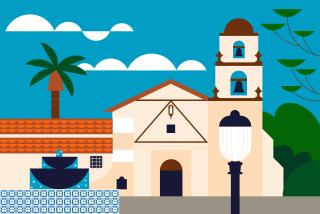Selling the Future as Fun
- Share via
If you hold a symposium on city planning, most people will stay home and watch TV. If, on the other hand, you throw a party, then maybe They Will Come.
That’s the theory behind FutureFest, the kickoff event for Ventura’s “Seize the Future” community visioning process, which will be held at Ventura College from 10 a.m. to 4 p.m. Saturday.
In part, FutureFest will be a community planning workshop at which you can learn more about the future of the city and present your own ideas. But it’s also meant to be a community fair, a place to have fun, enjoy good food and good entertainment, and--most important--make contact not just with planning experts but with the people and organizations that are already working to make Ventura better.
In undertaking the FutureFest, Ventura is joining other cities in adopting a new approach to community planning. For decades, community planners and civic leaders throughout the United States have been flummoxed by the problem of getting broad-based public participation for planning and visioning efforts.
The truth is that most people don’t have the time or inclination to turn out for planning workshops--which is understandable, given that we all lead busy lives and that planners have a way of making planning seem boring. So typically, one of two things happens. In many cases, an out-of-town consultant draws up a city plan--often a good one--but it just sits on the planning director’s shelf because no one in town has ever “claimed ownership” of it. In other cases, the future of the city is mapped out in private by a group of political insiders and business leaders--but because most people feel left out, sooner or later there’s a political backlash at the polls.
So how do you break this destructive cycle? In two ways. First, by understanding the entertainment value of the future--especially with special events. And second, by getting to the people of the community through the organizations they’re already involved in.
Special events have always heightened people’s interest in the future. A century ago, the Columbian Exposition--a world’s fair based in Chicago--stimulated excitement about city planning and architecture that spilled over into the new century and helped create some of the most wonderful city neighborhoods and parks ever built by spawning the City Beautiful movement. The New York World’s Fair of 1939 had a similar electrifying effect.
Ventura’s FutureFest is by no means a world’s fair. But it’s the same idea. By getting people together and showing them ideas, the FutureFest can stir up excitement and start a dialogue about the future in a way no planning symposium ever could.
The FutureFest will also try to drum up interest in another way: by working through (and highlighting the work of) successful community organizations that already exist. We planners may lament that people “don’t get involved.” But the truth is that any successful community has dozens--even hundreds--of active organizations that help make the town better: churches, youth sports leagues, social service groups, advocates for parks and libraries, environmental groups, business associations, and on and on.
*
These are the groups people identify with--and the ones they truly regard as their gateways to the community. And in my experience, the mark of a truly successful community is one in which different community organizations come together in unlikely alliances--a business association and a neighborhood group; parks advocates and economic development leaders--to get things done.
A couple of years ago, when I worked on a community technology project in Thousand Oaks, I was astonished at how effectively these groups interacted. I knew T.O. had lots of successful community organizations. But what made the town special was the fact that they all knew each other and often worked together. The whole of the town was greater than the sum of the parts.
At FutureFest, we’re hoping to foster some of the same cross-pollination. More than 50 community organizations will have booths and exhibits, showing people what they do and asking people to help them map the future of their organizations and the community as a whole.
FutureFest is just the beginning of a process in Ventura that will last at least until next summer, when the City Council is expected to approve a “strategic vision and action plan” for the future. But with luck, it will also mark the beginning of a whole new era of planning in these parts--one in which civic leaders aren’t afraid to be creative in asking people to be involved, and people aren’t afraid to respond.
*
William Fulton is editor of California Planning & Development Report and chair of the Seize the Future Citizen Outreach Committee. For more information about FutureFest, visit the city of Ventura’s Web site at www.ci.ventura.ca.us or call 677-3955.


